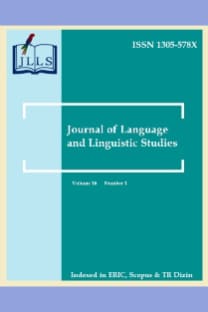Bloom Taksonomisi aracılığıyla dil değerlendirmesi
Language assessment through Bloom’s Taxonomy
___
- Almerico, G. M. & Baker, R.K. (2004). Bloom’s Taxonomy Illustrative Verbs: Developing a Comprehensive List for Educator Use. Florida Association of Teacher Educators Journal. 1(4), 1- 10.
- Assaly, I. R., & Smadi, O. M. (2015). Using Bloom’s Taxonomy to Evaluate the Cognitive Levels of Master Class Textbook’s Questions. English Language Teaching. 8(5), 100-110.
- Black, P., Harrison, C., & Lee, C. (2003). Assessment for learning: Putting it into practice. McGrawHill Education (UK).
- Bloom, B. S. (1956). Taxonomy of educational objectives. Vol. 1: Cognitive domain. New York: McKay, 20-24.
- Brualdi, A.C. (1998). Classroom questions. Practical Assessment Research & Evaluation.6/6.
- Chang, W. C., & Chung, M. S. (2009). Automatic applying Bloom's taxonomy to classify and analysis the cognition level of English question items. In 2009 Joint Conferences on Pervasive Computing (JCPC).
- Chin, C. (2004). Questioning Students in ways that encourage thinking. Teaching Science: The Journal of the Australian Science Teachers Association, 50(4).
- Cognition (2016). In The American Heritage Dictionary of the English Language. Retrieved March 20, 2016, from https://www.ahdictionary.com/word/search.html?q=cognition
- Eber, P. A., & Parker, T. S. (2007). Assessing Student Learning: Applying Bloom's Taxonomy. Human Service Education, 27(1).
- Freahat, N. M., & Smadi, O. M. (2014). Lower-order and Higher-order Reading Questions in Secondary and University Level EFL Textbooks in Jordan. Theory and Practice in Language Studies, 4(9), 1804-1813.
- Haris, S. S., & Omar, N. (2015). Bloom's Taxonomy Question Categorizatıon Using Rules and Ngram Approach. Journal of Theoretical & Applied Information Technology, 76(3).
- Jones, K. O., Harland, J., Reid, J., & Bartlett, R. (2009). Relationship between examination questions and Bloom's taxonomy. In Frontiers in Education Conference, 2009. FIE'09. 39th IEEE. 1-6.
- Kastberg, S. E. (2003). Using Bloom's Taxonomy as a framework for classroom assessment. The Mathematics Teacher, 96(6), 402-405.
- Krathwohl, D. R. (2002). A revision of Bloom's taxonomy: An overview. Theory into practice, 41(4), 212-218.
- Konza, D. (2011). Research into Practice. Understanding the reading process. Department of Education and Children’s Services. Government of South Australia. 1, 1-8.
- Leeds, D. (2000). The 7 powers of questions: Secrets to successful communication in life and at work. Penguin.
- Omar, N., Haris, S. S., Hassan, R., Arshad, H., Rahmat, M., Zainal, N. F. A., & Zulkifli, R. (2012). Automated analysis of exam questions according to Bloom's taxonomy. Procedia-Social and Behavioral Sciences, 59, 297-303.
- Ordem, E. (2016). Developing Critical-Thinking Dispositions in a Listening/Speaking Class. English Language Teaching, 10(1), 50.
- Orey, M. (2010). Emerging perspectives on learning, teaching, and technology. The Global Text Project. Jacobs Foundation: Switzerland.
- Paul, D. V., Naik, S. B., & Pawar, J. D. (2014). An Evolutionary Approach for Question Selection from a Question Bank: A Case Study. International Journal of ICT Research and Development in Africa (IJICTRDA), 4(1), 61-75.
- Robyn, E. (2014). Bloom's taxonomy. Denver, CO: ExpertBeacon. Retreived on the 30th of May, 2018 from http://expertbeacon.com/blooms-taxonomy/#.VZGfG0aIU0w
- Scott, T. (2003). Bloom’s Taxonomy Applied to Testing in Computer Science Classes. Consortium for Computing Science in Colleges: Rocky Mountain Conference. 267-274.
- Swart, A.J. (2010). Evaluation of Final Examination Papers in Engineering: A Case StudyUsing Bloom's Taxonomy. IEEE Transactions on Education. 53 (2), 257-264.
- Thompson, E., Luxton-Reilly, A., Whalley, J. L. Hu, M., P. Robbins. (2008). Bloom's Taxonomy for CS Assessment. Proceeding Tenth Australasian Computing Education Conference (ACE 2008), Wollongong, Australia. 155-162.
- Veeravagu, J., Muthusamy, C., Marimuthu, R., & Michael, A. S. (2010). Using Bloom's Taxonomy to Gauge Students' Reading Comprehension Performance/Utiliser La Taxonomie De Bloom Pour Evaluer Les Performances De Comprehension Ecrite Des Eleves. Canadian Social Science, 6(3), 205.
- Zareian, G., Davoudi, M., Heshmatifar, Z., & Rahimi, J. (2015). An Evaluation of Questions in Two ESP Coursebooks Based on Bloom’s New Taxonomy of Cognitive Learning Domain. International Journal of Education and Research. 3(8), 313-326.
- Zoller, U. & Tsaparlis, G. (1997). Higher and lower-order cognitive skills: The case of chemistry. Research in Science Education, 27,117- 130.
- ISSN: 1305-578X
- Yayın Aralığı: 4
- Başlangıç: 2005
- Yayıncı: http://www.jlls.org
İngilizce öğretmen adaylarının akademik öz yeterlik ve akademik erteleme davranışları
Türk çocuklarının anadil ve yabancı dil yetilerinin çözümlenmesi
Immersion vs. construction: The portrayals of culture in Indonesian EFL learning paradigm
Ruly MORGANNA, Sumardi SUMARDİ, Sri Samiati TARJANA
İngilizce öğretmenliğinde yaratıcı drama dersi için ders izlencesi önerisi
Paşa Tevfik CEPHE, Seçil HORASAN DOĞAN
Sabahattin YEŞİLÇINAR, Abdulvahit ÇAKIR
Yabancı dil öğrenme ortamlarında dinleme öğretimi bilinçli mi yoksa bilinçsiz mi terk ediliyor?
